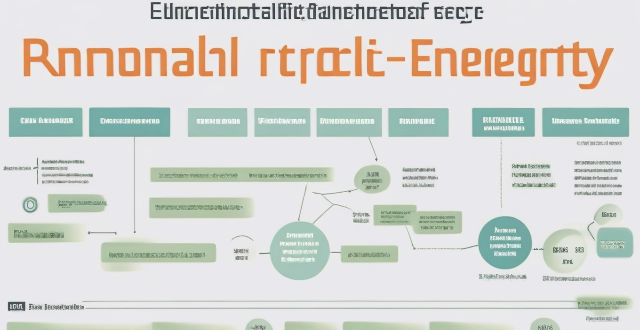Energy Sector

How can the energy sector reduce its water footprint through innovations in technology ?
The energy sector's substantial water consumption is a concern for sustainable development. Technological innovations, such as efficient cooling systems, advanced water treatment, renewable energy integration, smart water management, waste heat recovery, and improved desalination methods, can help reduce the sector's water footprint. These innovations offer benefits like resource conservation, cost efficiency, and reduced environmental impact, ultimately contributing to global water security.

Can private sector investments play a significant role in climate financing ?
The article discusses the potential of private sector investments in climate financing, highlighting their current involvement and potential impact on various aspects such as access to larger pools of capital, innovation, risk management, and scaling up successful approaches. It also addresses challenges and considerations like alignment with public goals, transparency, inclusivity, and regulatory frameworks. The conclusion emphasizes the importance of collaboration between public and private sectors for effective utilization of private capital in climate action.

How do energy-efficient buildings contribute to reducing carbon emissions in the construction sector ?
Energy-efficient buildings are crucial in the construction sector for reducing carbon emissions, which contribute significantly to global warming and climate change. The importance of urgent action is emphasized by the IPCC's warning about the limited timeframe to limit global warming to 1.5°C above pre-industrial levels. Energy-efficient buildings can reduce energy consumption, lower energy bills, improve comfort and health, and contribute to long-term sustainability. Strategies for achieving energy efficiency include passive design strategies, high-performance building envelopes, advanced HVAC systems, retrofitting existing buildings with energy audits and renewable energy sources. Collective action from various stakeholders is necessary to make significant progress towards a sustainable future.

What are some best practices for climate risk management in the agricultural sector ?
Climate risk management is critical for the agricultural sector, which faces significant vulnerabilities due to changing weather patterns and extreme events. Key practices include assessing climate risks, integrating climate information into decision-making, enhancing ecosystem resilience, building human capacity, and planning financially with insurance. By adopting these strategies, farmers can adapt to climate change and reduce their risks, ensuring a more resilient agricultural sector.

How can policymakers encourage private sector involvement in climate adaptation ?
To encourage private sector involvement in climate adaptation, policyTo encourage private sector involvement in climate adaptation, policy as creating incentives like tax policymakers can implement strategies such as creating incentives like tax breaks and subsidies, establishing clear regulations with compliance enforcement, facilitating information sharing through open data access and collaborative platforms, promoting public-private partnerships with joint projects and long-term commitments, enhancing capacity building via training programs and technical assistance, and recognizing and showcasing success stories through awards and media coverage. These steps will foster a collaborative environment where the private sector actively seeks opportunities to contribute to resilient and sustainable solutions for climate change challenges.

How does Fintech drive innovation in the financial sector ?
Fintech is driving innovation in the financial sector by enhancing efficiency, democratizing access to services, improving customer experience, facilitating financial inclusion, enhancing security and compliance, and fostering innovation and collaboration.

How does economic recovery affect different industries differently ?
Economic recovery affects industries differently based on their reliance on consumer spending, investment, government policies, and global markets. Consumer discretionary sectors like retail and hospitality are highly sensitive to economic fluctuations but can rebound quickly with increased consumer confidence. The technology sector often remains resilient during downturns, with continued growth in segments like software and online services. Manufacturing may face challenges due to supply chain disruptions but can rapidly expand with demand recovery. Financial services benefit from improved credit conditions and increased lending activities. Healthcare is generally less affected by economic cycles and can grow with aging populations. Energy sector recovery depends on global demand and policy shifts towards renewable energy. Understanding these differential impacts is crucial for investors, policymakers, and businesses to navigate the changing landscape effectively.

What is the future outlook for clean energy investment ?
The future outlook for clean energy investment is positive, driven by government policies, technological advancements, and growing demand for sustainable energy sources. However, challenges related to intermittency, infrastructure integration, and competition from fossil fuels need to be addressed to ensure the continued growth of the sector.

What are the current trends in renewable energy policies globally ?
The global community is increasingly prioritizing renewable energy policies as part of efforts to combat climate change and reduce carbon emissions. Governments are offering financial incentives, setting ambitious targets for renewable energy consumption, promoting energy efficiency, and encouraging private sector investment in clean energy projects. These trends reflect a worldwide commitment to creating a more sustainable future through the adoption of renewable energy sources.

What impact do energy storage solutions have on the economics of renewable energy ?
Energy storage solutions significantly impact renewable energy economics by addressing variability and unpredictability. They enhance grid stability, reduce costs, and increase efficiency, thus making renewable energy more viable. With ongoing technological advancements, energy storage will continue to play a crucial role in integrating renewable energy into power grids and achieving global decarbonization goals.

How do renewable energy policies influence innovation and technology development ?
Renewable energy policies are crucial for driving innovation and technology development in the clean energy sector. These policies provide incentives for research, investment, and deployment, creating a favorable environment for technological advancements and innovation. Government support and funding, regulatory frameworks, market incentives, and collaboration and partnerships are all essential factors that influence innovation and technology development in this sector. By providing financial assistance, setting standards and requirements, creating demand for clean energy solutions, and fostering collaboration between different stakeholders, renewable energy policies help to accelerate the development of new technologies and improve existing ones. As we continue to face challenges related to climate change and energy security, it is essential that we continue to invest in renewable energy solutions and support policies that encourage innovation and progress in this field.

What impact does climate change legislation have on renewable energy development ?
Climate change legislation significantly influences renewable energy development by providing financial incentives, establishing mandated targets, supporting research and infrastructure, creating consumer awareness, fostering international cooperation, implementing regulations, setting environmental standards, and promoting economic growth through job creation. These measures collectively drive the energy sector towards sustainability and a low-carbon future.

How do international climate agreements influence national policies on renewable energy ?
International climate agreements significantly shape national renewable energy policies by setting targets, offering financial aid and technology transfer, promoting innovation and collaboration, and creating market opportunities. This influence is evident in countries' ambitious renewable energy goals, their participation in global initiatives, and the growth of related industries. Such concerted efforts are crucial for achieving a sustainable, low-carbon future.

What countries are leading in wind energy production ?
The leading countries in wind energy production are China, the United States, Germany, India, and Spain. China has the largest installed capacity with 282 GW as of 2021, followed by the US with 119 GW, Germany with 60 GW, India with 38 GW, and Spain with 26 GW. These countries have seen rapid growth and innovation in their wind energy sectors, with key regions and states contributing significantly to their overall output. Their efforts demonstrate a commitment to reducing carbon emissions and transitioning towards sustainable energy sources.

What are the risks associated with investing in clean energy ?
Investing in clean energy is beneficial for the environment and potentially profitable in the long term, but it comes with its own set of risks. Some of the key risks associated with investing in clean energy include technology risk, market risk, operational risk, regulatory risk, financial risk, environmental risk, and social and political risk. It's essential to be aware of these risks and manage them effectively to ensure successful investments in this sector.

How can private sector participate in climate financing ?
Private sector participation in climate financing can take various forms, including direct investments in renewable energy projects, issuing green bonds or sustainable investment funds, carbon credit trading, R&D for innovative climate solutions, forming partnerships, adopting circular economy models, implementing eco-friendly business practices, maintaining transparency in environmental impact reporting, providing philanthropic support, and engaging employees in sustainability efforts. These actions not only mitigate climate change but also often improve corporate reputation and open new markets.

What steps can governments take to promote renewable energy jobs ?
Governments can promote renewable energy jobs through various policies and incentives. They can implement regulations like Renewable Portfolio Standards, Feed-in Tariffs, Net Metering Laws, and Renewable Energy Certificates. Financial incentives such as tax credits, grants, loans, and investment tax exemptions can also be provided. Governments can support research and development by funding studies, collaborating with academia, forming public-private partnerships, and supporting startups. Education and training programs, infrastructure development, streamlining permitting processes, encouraging local production and consumption, and international cooperation are other steps that can be taken to promote renewable energy jobs.

What is energy transition and why is it important ?
Text: Energy transition is the shift from traditional to renewable energy sources, important for reducing greenhouse gas emissions, promoting sustainable development, and improving energy security. Benefits include economic growth, environmental protection, and social progress.

How has the Clean Energy Revolution affected the job market ?
The clean energy revolution has created new job opportunities across various sectors, including solar, wind, geothermal, hydropower, and bioenergy. The industry requires specialized skills in engineering, manufacturing, maintenance, sales, marketing, policy analysis, and advocacy. The clean energy revolution has also transformed existing industries by integrating renewable energy sources into their operations. The shift towards renewable energy sources is expected to continue, requiring individuals to acquire the necessary skills and knowledge to thrive in this rapidly evolving landscape.

What role do governments play in promoting clean energy investment ?
Governments play a crucial role in promoting clean energy investment by implementing policies and regulations that encourage the development and adoption of renewable energy sources. These efforts are essential for reducing greenhouse gas emissions, mitigating climate change, and achieving sustainable economic growth. This article will discuss some of the key ways governments can promote clean energy investment. Governments can set ambitious renewable energy targets to drive the transition towards a low-carbon economy. By establishing specific goals for renewable energy generation, governments create a clear direction for the industry and provide certainty for investors. For example, governments can set national targets for the share of renewable energy in total energy consumption or electricity generation, or mandate that a certain percentage of electricity must come from renewable sources, encouraging utilities to invest in clean energy projects. Governments can offer financial incentives to attract private sector investment in clean energy projects. These incentives can include feed-in tariffs, tax credits and exemptions, grants, and low-interest loans. Investment in research and development (R&D) is crucial for advancing clean energy technologies and driving down costs. Governments can support R&D through public funding, collaborative partnerships, and innovation grants. Complex regulatory processes can be a barrier to clean energy investment. Governments can streamline these processes by simplifying permitting and providing clear guidelines. Investing in infrastructure and supportive systems is essential for the widespread adoption of clean energy. Governments can contribute by developing energy storage solutions, upgrading transmission networks, and supporting smart grid development. Public awareness and consumer demand are critical factors in driving clean energy investment. Governments can influence these factors by launching public awareness campaigns and offering consumer incentives such as rebates or tax credits for installing renewable energy systems in homes or businesses. In conclusion, governments have a multifaceted role in promoting clean energy investment. By setting targets, providing financial incentives, supporting R&D, streamlining regulations, building infrastructure, and educating the public, governments can create an environment conducive to the growth of the renewable energy sector. These efforts are essential for transitioning to a sustainable, low-carbon future and addressing the urgent challenge of climate change.

What impact does energy transition have on employment and job creation ?
The energy transition from fossil fuels to renewable sources significantly impacts job creation and employment. This shift brings growth in renewable energy sectors, green economy expansion, research & development, infrastructure development, and energy efficiency services. However, it also causes employment shifts such as a decline in fossil fuel industries, skill transition, geographical impact, supply chain effects, and policy-driven changes. Managing these challenges through strategies like reskilling programs and supportive policies is crucial for a just and equitable energy future.

What are the major sources of climate finance and how are they allocated ?
The text discusses the main sources of climate finance, which include public sector funding, private sector investment, and multilateral institutions. Public sector funding is provided through government budgets, international climate funds, and domestic climate funds. Private sector investment comes from corporate sustainability initiatives, private climate funds, and impact investing. Multilateral institutions such as development banks, international financial institutions, and United Nations agencies also contribute to climate finance. These sources are crucial for supporting climate action globally, with allocations focused on reducing greenhouse gas emissions, adapting to the impacts of climate change, and promoting sustainable development.

What are the current challenges in scaling up wind energy production globally ?
The article discusses the various challenges that need to be addressed in order to scale up wind energy production globally. These include infrastructure development, technological barriers, environmental impact, economic factors, regulatory issues, and social acceptance. Overcoming these obstacles requires collaborative efforts from all stakeholders involved in the wind energy sector.

How can data analytics help identify areas for energy efficiency improvements in industry ?
Data analytics is crucial for identifying opportunities for energy efficiency improvements in industry. It enables real-time and historical monitoring, benchmarking, process optimization, predictive maintenance, and demand response management. These insights help companies reduce energy waste, cut costs, and minimize environmental impact.

What role does renewable energy play in reducing carbon footprint ?
Renewable energy is crucial in reducing carbon footprint as it is obtained from natural resources and does not emit harmful greenhouse gases. It benefits the environment, economy, and society by mitigating climate change, reducing dependence on imported fuels, and providing affordable energy to remote areas. Solar, wind, hydro, geothermal, and biomass energy are types of renewable energy sources. However, challenges such as cost, intermittency, storage, and grid integration need to be addressed. Continued investment and innovation can make renewable energy more accessible and affordable for everyone.

What are the potential returns on investment for clean energy projects ?
Investing in clean energy projects offers potential financial, environmental, and social returns. Factors such as capital appreciation, dividends, tax credits, carbon emission reductions, air quality improvements, job creation, and energy security contribute to the overall benefits of these investments. As the global transition towards a low-carbon economy progresses, investing in clean energy projects presents a wise and sustainable option for investors seeking both positive impact and financial gains.

How does clean energy investment impact the environment ?
Clean energy investment positively affects the environment in various ways, including reducing greenhouse gas emissions, conserving natural resources, improving air quality, promoting sustainable practices, and enhancing long-term energy security. These efforts help mitigate climate change, protect ecosystems, reduce pollutants, encourage innovation and job creation, and stabilize energy prices. As environmental challenges persist, prioritizing clean energy investment is crucial for the planet's health and future generations.

Is wind energy a viable option for developing countries ?
Is wind energy a viable option for developing countries? Yes, wind energy offers numerous benefits such as cost-effectiveness, sustainability, job creation, and improved energy security. However, several challenges must be addressed including infrastructure needs, financing barriers, policy development, and environmental considerations. With careful planning and strategic investments, wind energy can indeed be a viable option for developing countries looking to build a sustainable future.

How can Smart Grid Technology improve energy efficiency ?
Smart grid technology is transforming the energy sector by integrating advanced communication technologies, automated controls, and innovative sensors to create a more efficient, reliable, and sustainable energy system. Key features of smart grid technology include Advanced Metering Infrastructure (AMI), Distributed Energy Resources (DERs), Demand Response (DR) Programs, and Electric Vehicles (EVs). The benefits of smart grid technology on energy efficiency include improved load management through peak shaving, demand side management, and dynamic pricing; increased renewable energy integration through microgrids, grid balancing, and energy storage systems; optimized transmission and distribution through self-healing networks, predictive maintenance, and reduced transmission losses; and enhanced customer engagement and participation through consumer education, incentives for energy efficiency, and community solar programs. Overall, smart grid technology offers numerous opportunities to improve energy efficiency across various sectors of the energy industry while transitioning towards a more sustainable future with reliable and efficient energy delivery for all consumers.

What is the role of international cooperation in shaping renewable energy policies ?
The text discusses the importance of international cooperation in developing renewable energy policies worldwide. It highlights three main benefits: sharing knowledge and best practices, accessing financing and investment opportunities, and addressing global challenges such as climate change, air pollution, and energy security. Examples are provided for each benefit, including technical workshops, research collaborations, policy forums, multilateral development bank loans, green bonds, private sector partnerships, climate change agreements, joint research efforts, and energy security initiatives. The conclusion emphasizes that international cooperation is crucial for accelerating the transition to a more sustainable and equitable energy system.